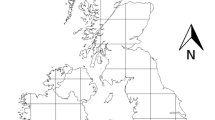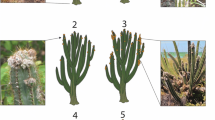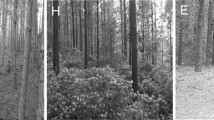Abstract
This study examined the effects of the native cactus moth borer, Melitara prodenialis, and the invasive cactus moth borer, Cactoblastis cactorum, on two common cactus species, Opuntia stricta and O. humifusa at coastal and inland locations in central Florida. Opuntia stricta were present only at coastal sites and O. humifusa were present at coastal and inland sites. Throughout the duration of the study, coastal plants were subject to damage solely by C. cactorum and inland plants solely by M. prodenialis. Results showed marginally significantly higher numbers of eggsticks on O. stricta than O. humifusa and significantly higher numbers at coastal sites than at inland sites. There was also significantly higher moth damage on O. stricta than O. humifusa and at coastal sites than inland sites, but not significantly so. However, there was a higher level of plant mortality for O. humifusa than for O. stricta and a significantly higher level of cactus mortality at inland sites when compared to coastal sites. This increased mortality may be due to increased attack by true bugs, Chelinidea vittiger, and by Dactylopius sp., combined with attack by M. prodenialis. Inland plants also tended to be smaller than coastal plants and could be more susceptible to the combined effects of all insects. Further long-term research on coastal cactus survival when attacked and unattacked by Cactoblastis is necessary to fully determine the effects of this moth on Opuntia survival.
Similar content being viewed by others
References
Dodd AP (1940) The biological campaign against prickly-pear. The Commonwealth Prickly Pear Board, Brisbane, Australia
Gibson AG, Nobel PS (1986) The cactus primer. Harvard University Press, Cambridge, Massachusetts
Habeck DH, Bennett FD (1990) Cactoblastis cactorum Berg (Lepidoptera: Pyralidae), a Phycitine new to Florida. Entomology Circular No. 333, Florida Deptartment of Agriculture and Consumer Services, Division of Plant Industries
Hoffmann JH, Zimmermann HG (1989) Ovipositional and feeding habits in cactophagous pyralids: prediction for biological control of cactus weeds. In: Delfosse ES (ed) Proceedings of the VII Symposium on Biological Control of Weeds. MAF, Rome, pp 395–399
Irish M (2001) The ornamental prickly pear industry in the southwestern United States. Fla Entomol 84:484–485
Johnson DM, Stiling PD (1996) Host specificity of Cactoblastis cactorum (Lepidoptera: Pyralidae), an exotic Opuntia-feeding moth, in Florida. Environ Entomol 25:743–748
Johnson DM, Stiling PD (1998) Distribution and dispersal of Cactoblastis cactorum (Lepidoptera: Pyralidae), an exotic Opuntia-feeding moth, in Florida. Fla Entomol 81:12–22
Mann J (1969) Cactus-feeding insects and mites. Bulletin 256, Smithsonian Institution, Washington D.C.
Soberon J, Golubov J, Sarukhan J (2001) The importance of Opuntia in Mexico and routes of invasion and impact of Cactoblastis cactorum (Lepidoptera: Pyralidae). Fla Entomol 84:486–492
Stiling P (2002) Potential non-target effects of a biological control agent, prickly pear moth, Cactoblastis cactorum (Berg) (Lepidoptera: Pyralidae), in North America, and possible management actions. Biol Invasions 4:273–281
Wunderlin RP, Hansen BF (2003) Guide to the vascular plants of Florida, 2nd edn. University Press of Florida, Gainesville, Florida
Acknowledgements
Financial support was provided by NSF grant DEB 03-15190. We are grateful to the staff at Lake Wales Ridge State Forest, Crooked Lake Prairie, Archbold Biological Research Station, Honeymoon Island State Park, Lido Beach Park and Fort de Soto Park for allowing us to work at these sites.
Author information
Authors and Affiliations
Corresponding author
Rights and permissions
About this article
Cite this article
Baker, A.J., Stiling, P. Comparing the effects of the exotic cactus-feeding moth, Cactoblastis cactorum (Berg) (Lepidoptera: Pyralidae) and the native cactus-feeding moth, Melitara prodenialis (Walker) (Lepidoptera: Pyralidae) on two species of Florida Opuntia . Biol Invasions 11, 619–624 (2009). https://doi.org/10.1007/s10530-008-9276-4
Received:
Accepted:
Published:
Issue Date:
DOI: https://doi.org/10.1007/s10530-008-9276-4




